Podcast
Questions and Answers
What is the main difference in the definition between Direct Immunofluorescence (DIF) and Indirect Immunofluorescence Assay (IDIFA)?
What is the main difference in the definition between Direct Immunofluorescence (DIF) and Indirect Immunofluorescence Assay (IDIFA)?
DIF detects antigens using a directly labeled primary antibody, while IDIFA detects antibodies in serum by binding them to antigens with a secondary labeled antibody.
Explain the step difference between Direct Immunofluorescence and Indirect Immunofluorescence.
Explain the step difference between Direct Immunofluorescence and Indirect Immunofluorescence.
DIF involves a single step where the antigen is combined with a labeled antibody, whereas IDIFA consists of two steps: first the antigen binds to the primary antibody, then a labeled secondary antibody is added.
Which assay is generally considered more versatile, and why?
Which assay is generally considered more versatile, and why?
Indirect Immunofluorescence Assay (IDIFA) is more versatile because it can utilize different primary antibodies with the same labeled secondary antibody.
Compare the sensitivity of Direct Immunofluorescence and Indirect Immunofluorescence.
Compare the sensitivity of Direct Immunofluorescence and Indirect Immunofluorescence.
Which assay is typically faster and less expensive, and what contributes to its cost-effectiveness?
Which assay is typically faster and less expensive, and what contributes to its cost-effectiveness?
What is the primary purpose of Direct Immunofluorescence (DIF)?
What is the primary purpose of Direct Immunofluorescence (DIF)?
How does a fluorescent dye function in Immunofluorescence techniques?
How does a fluorescent dye function in Immunofluorescence techniques?
What are the steps involved in preparing a slide for Direct Immunofluorescence?
What are the steps involved in preparing a slide for Direct Immunofluorescence?
What differentiates Indirect Immunofluorescence Assay (IDIFA) from Direct Immunofluorescence (DIF)?
What differentiates Indirect Immunofluorescence Assay (IDIFA) from Direct Immunofluorescence (DIF)?
Explain the role of the secondary antibody in IDIFA.
Explain the role of the secondary antibody in IDIFA.
What role does fluorescence detection play in both DIF and IDIFA?
What role does fluorescence detection play in both DIF and IDIFA?
Describe the significance of using a slide coated with a specific antigen in IDIFA.
Describe the significance of using a slide coated with a specific antigen in IDIFA.
What types of light do fluorescein isothiocyanate (FITC) and Tetramethylrhodamine emit?
What types of light do fluorescein isothiocyanate (FITC) and Tetramethylrhodamine emit?
Flashcards
Immunofluorescence
Immunofluorescence
A technique to visualize antigens using fluorescently labeled antibodies.
Fluorescent Dyes
Fluorescent Dyes
Substances that absorb UV light and emit visible light.
Direct Immunofluorescence (DIF)
Direct Immunofluorescence (DIF)
Technique using one fluorescently labeled antibody to detect antigens.
Indirect Immunofluorescence Assay (IDIFA)
Indirect Immunofluorescence Assay (IDIFA)
Signup and view all the flashcards
Sample Preparation
Sample Preparation
Signup and view all the flashcards
Fluorescence Detection
Fluorescence Detection
Signup and view all the flashcards
Antigen Coating
Antigen Coating
Signup and view all the flashcards
Patient Serum Incubation
Patient Serum Incubation
Signup and view all the flashcards
Sensitivity in DIF vs IDIFA
Sensitivity in DIF vs IDIFA
Signup and view all the flashcards
Application of DIF
Application of DIF
Signup and view all the flashcards
Time and Cost Comparison
Time and Cost Comparison
Signup and view all the flashcards
Study Notes
Immunofluorescence
- Immunofluorescence is a technique for visualizing specific antigens.
- It involves binding a specific antibody to the antigen. The antibody is chemically linked to a fluorescent dye.
- This allows the antigen to be visualized using a microscope.
- Fluorescent dyes absorb short-wavelength ultraviolet (UV) light and emit longer-wavelength light, which is visible.
- Examples of fluorescent dyes include fluorescein isothiocyanate (FITC) and tetramethylrhodamine.
- FITC emits green light, and tetramethylrhodamine emits red light.
- Immunofluorescence can enhance the visibility of viral plaques to the human eye.
Principle of Immunofluorescence (IF)
- The principle behind immunofluorescence is the specific interaction between an antibody and its corresponding antigen.
- A labelled antibody binds to the antigen.
- When exposed to UV or specific wavelengths of light, the fluorescent dye in the antibody emits visible light.
- This allows for the visualization of antigen-antibody complexes.
- The principle is based on antigen-antibody interaction.
Requirements for Immunofluorescence
- A slide is a required material for the procedure.
- A tagged antibody is a fundamental element.
- A fluorescent microscope is needed for visualization.
- Specimen or tissue sections are necessary.
Methods of Immunofluorescence Assay
- Two main types of immunofluorescence assays exist: direct and indirect.
Direct Immunofluorescence Assay (DIFA)
- Detects specific antigens using a single primary antibody.
- The primary antibody is directly conjugated with a fluorescent dye.
- The process involves fixing tissue sections or cells onto a slide.
- Applying the fluorescently labeled antibody specific to the target antigen to the sample.
- Antibody binds directly to the antigen.
- Observing the slide under a fluorescence microscope, detecting fluorescence confirms the target antigen's presence.
Indirect Immunofluorescence Assay (IDIFA)
- Detects specific antibodies.
- It involves the interaction with a known antigen, then using a secondary fluorescently-labeled antibody.
- The procedure involves coating a slide or substrate with a specific antigen.
- Adding the patient's serum sample to the slide. If the target antibodies are present, they bind to the antigen.
- Adding a secondary antibody that is specifically conjugated to a fluorescent dye and will bind to the patient's antibody.
- Observing the slide under a fluorescence microscope, detecting fluorescence confirms the presence of specific antibodies.
Comparison between Direct and Indirect Immunofluorescence
| Aspect | Direct Immunofluorescence (DIF) | Indirect Immunofluorescence Assay (IDIFA) |
|---|---|---|
| Definition | Detects antigens using a primary antibody directly conjugated to a fluorescent dye. | Detects antibodies in a sample by binding them to an antigen and using a secondary fluorescently labeled antibody. |
| Fluorescence Label | Primary antibody is fluorescently labeled. | Secondary antibody is fluorescently labeled. |
| Steps | Single step: Antigen + labeled antibody. | Two steps: Antigen + primary antibody, then labeled secondary antibody.. |
| Purpose | Identifies antigens directly. | Detects antibodies present in a serum sample. |
| Specificity | Highly specific but limited to the labeled antibody. | More versatile, as different primary antibodies can be used with the same secondary antibody. |
| Sensitivity | Lower sensitivity due to lack of signal amplification. | Higher sensitivity due to signal amplification. |
| Applications | Used in pathology to detect tissue-bound antigens. | Commonly used in serological tests and autoimmune or infectious disease studies. |
| Time and Cost | Faster and generally cheaper (fewer reagents). | More time-consuming and potentially more expensive (additional reagents needed). |
Result of Immunofluorescence
- A confocal image example demonstrates the process's ability to detect phosphorylated AKT (green) in cardiomyocytes infected with adenovirus.
Studying That Suits You
Use AI to generate personalized quizzes and flashcards to suit your learning preferences.




